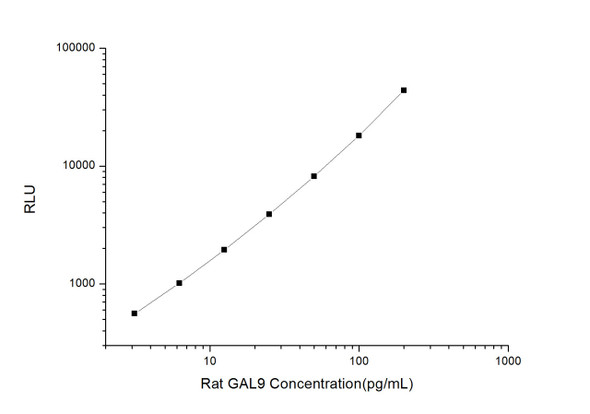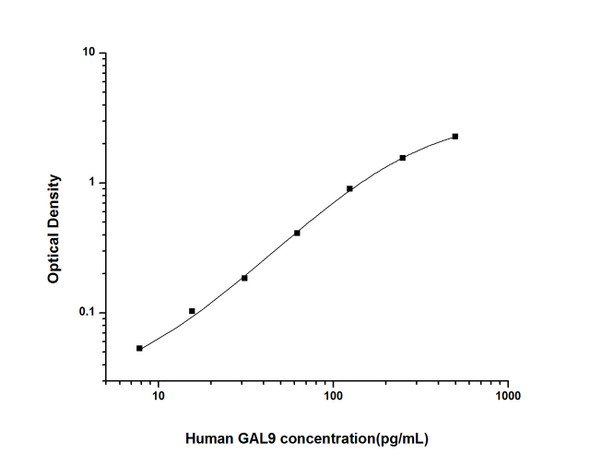Human Cell Biology ELISA Kits 4
Human GAL9 (Galectin 9 ) CLIA Kit (HUES00624)
- SKU:
- HUES00624
- Product Type:
- ELISA Kit
- ELISA Type:
- CLIA Kit
- Size:
- 96 Assays
- Sensitivity:
- 4.69pg/mL
- Range:
- 7.81-500pg/mL
- ELISA Type:
- Sandwich
- Reactivity:
- Human
- Sample Type:
- Serum, plasma and other biological fluids
- Research Area:
- Cell Biology
Description
| Assay type: | Sandwich |
| Format: | 96T |
| Assay time: | 4.5h |
| Reactivity: | Human |
| Detection method: | Chemiluminescence |
| Detection range: | 7.81-500 pg/mL |
| Sensitivity: | 4.69 pg/mL |
| Sample volume: | 100µL |
| Sample type: | Serum, plasma and other biological fluids |
| Repeatability: | CV < 15% |
| Specificity: | This kit recognizes Human GAL9 in samples. No significant cross-reactivity or interference between Human GAL9 and analogues was observed. |
This kit uses Sandwich-CLIA as the method. The micro CLIA plate provided in this kit has been pre-coated with an antibody specific to Human GAL9. Standards or samples are added to the appropriate micro CLIA plate wells and combined with the specific antibody. Then a biotinylated detection antibody specific for Human GAL9 and Avidin-Horseradish Peroxidase (HRP) conjugate are added to each micro plate well successively and incubated. Free components are washed away. The substrate solution is added to each well. Only those wells that contain Human GAL9, biotinylated detection antibody and Avidin-HRP conjugate will appear fluorescence. The Relative light unit (RLU) value is measured spectrophotometrically by the Chemiluminescence immunoassay analyzer. The RLU value is positively associated with the concentration of Human GAL9. The concentration of Human GAL9 in the samples can be calculated by comparing the RLU of the samples to the standard curve.
| UniProt Protein Function: | galectin-9: Binds galactosides. Has high affinity for the Forssman pentasaccharide. May play a role in thymocyte-epithelial interactions relevant to the biology of the thymus. Inhibits cell proliferation. It is a ligand for HAVCR2/TIM3. Induces T-helper type 1 lymphocyte (Th1) death. Isoform Short acts as an eosinophil chemoattractant. 2 isoforms of the human protein are produced by alternative splicing. |
| UniProt Protein Details: | Protein type:Unknown function Chromosomal Location of Human Ortholog: 17q11. 2 Cellular Component: cytoplasm; extracellular space; intracellular; nucleus Molecular Function:carbohydrate binding; disaccharide binding; enzyme binding; galactose binding; signal transducer activity Biological Process: activation of NF-kappaB transcription factor; female pregnancy; inflammatory response; maternal process involved in pregnancy; natural killer cell tolerance induction; negative regulation of activated T cell proliferation; negative regulation of chemokine production; negative regulation of interferon-gamma production; negative regulation of mast cell degranulation; negative regulation of natural killer cell mediated cytotoxicity; negative regulation of tumor necrosis factor production; positive regulation of CD4-positive, CD25-positive, alpha-beta regulatory T cell differentiation during immune response; positive regulation of I-kappaB kinase/NF-kappaB cascade; positive regulation of interleukin-1 beta secretion; positive regulation of interleukin-4 production; positive regulation of NF-kappaB import into nucleus; positive regulation of virion penetration into host cell; regulation of interleukin-4 production; regulation of interleukin-5 production; response to lipopolysaccharide; toll-like receptor 2 signaling pathway; toll-like receptor 4 signaling pathway |
| NCBI Summary: | The galectins are a family of beta-galactoside-binding proteins implicated in modulating cell-cell and cell-matrix interactions. The protein encoded by this gene is an S-type lectin. It is overexpressed in Hodgkin's disease tissue and might participate in the interaction between the H&RS cells with their surrounding cells and might thus play a role in the pathogenesis of this disease and/or its associated immunodeficiency. Multiple alternatively spliced transcript variants have been found for this gene. [provided by RefSeq, Jul 2008] |
| UniProt Code: | O00182 |
| NCBI GenInfo Identifier: | 3041694 |
| NCBI Gene ID: | 3965 |
| NCBI Accession: | O00182. 2 |
| UniProt Secondary Accession: | O00182,O14532, O75028, Q3B8N1, Q53FQ0, Q8WYQ7, Q9NQ58 A7VJG6, F8W9W4, |
| UniProt Related Accession: | O00182 |
| Molecular Weight: | 38,321 Da |
| NCBI Full Name: | Galectin-9 |
| NCBI Synonym Full Names: | galectin 9 |
| NCBI Official Symbol: | LGALS9 |
| NCBI Official Synonym Symbols: | HUAT; LGALS9A |
| NCBI Protein Information: | galectin-9 |
| UniProt Protein Name: | Galectin-9 |
| UniProt Synonym Protein Names: | Ecalectin; Tumor antigen HOM-HD-21 |
| Protein Family: | Galectin |
| UniProt Gene Name: | LGALS9 |
| UniProt Entry Name: | LEG9_HUMAN |
As the RLU values of the standard curve may vary according to the conditions of the actual assay performance (e. g. operator, pipetting technique, washing technique or temperature effects), the operator should establish a standard curve for each test. Typical standard curve and data is provided below for reference only.
| Concentration (pg/mL) | RLU | Average | Corrected |
| 500 | 48836 54238 | 51537 | 51508 |
| 250 | 20309 21687 | 20998 | 20969 |
| 125 | 9507 9285 | 9396 | 9367 |
| 62.5 | 4185 4839 | 4512 | 4483 |
| 31.25 | 2419 2179 | 2299 | 2270 |
| 15.63 | 1298 1202 | 1250 | 1221 |
| 7.81 | 738 742 | 740 | 711 |
| 0 | 28 30 | 29 | -- |
Precision
Intra-assay Precision (Precision within an assay): 3 samples with low, mid range and high level Human GAL9 were tested 20 times on one plate, respectively.
Inter-assay Precision (Precision between assays): 3 samples with low, mid range and high level Human GAL9 were tested on 3 different plates, 20 replicates in each plate.
| Intra-assay Precision | Inter-assay Precision | |||||
| Sample | 1 | 2 | 3 | 1 | 2 | 3 |
| n | 20 | 20 | 20 | 20 | 20 | 20 |
| Mean (pg/mL) | 27.74 | 78.32 | 183.16 | 25.84 | 82.50 | 170.61 |
| Standard deviation | 3.37 | 8.38 | 17.25 | 2.80 | 9.31 | 19.48 |
| C V (%) | 12.15 | 10.70 | 9.42 | 10.84 | 11.28 | 11.42 |
Recovery
The recovery of Human GAL9 spiked at three different levels in samples throughout the range of the assay was evaluated in various matrices.
| Sample Type | Range (%) | Average Recovery (%) |
| Serum (n=5) | 86-100 | 91 |
| EDTA plasma (n=5) | 89-101 | 94 |
| Cell culture media (n=5) | 95-109 | 102 |
Linearity
Samples were spiked with high concentrations of Human GAL9 and diluted with Reference Standard & Sample Diluent to produce samples with values within the range of the assay.
| Serum (n=5) | EDTA plasma (n=5) | Cell culture media (n=5) | ||
| 1:2 | Range (%) | 91-102 | 102-118 | 102-121 |
| Average (%) | 97 | 108 | 110 | |
| 1:4 | Range (%) | 83-96 | 97-112 | 92-102 |
| Average (%) | 90 | 103 | 97 | |
| 1:8 | Range (%) | 99-113 | 86-97 | 97-111 |
| Average (%) | 105 | 91 | 103 | |
| 1:16 | Range (%) | 95-110 | 95-108 | 98-114 |
| Average (%) | 101 | 102 | 104 |
An unopened kit can be stored at 4°C for 1 month. If the kit is not used within 1 month, store the items separately according to the following conditions once the kit is received.
| Item | Specifications | Storage |
| Micro CLIA Plate(Dismountable) | 8 wells ×12 strips | -20°C, 6 months |
| Reference Standard | 2 vials | |
| Concentrated Biotinylated Detection Ab (100×) | 1 vial, 120 µL | |
| Concentrated HRP Conjugate (100×) | 1 vial, 120 µL | -20°C(shading light), 6 months |
| Reference Standard & Sample Diluent | 1 vial, 20 mL | 4°C, 6 months |
| Biotinylated Detection Ab Diluent | 1 vial, 14 mL | |
| HRP Conjugate Diluent | 1 vial, 14 mL | |
| Concentrated Wash Buffer (25×) | 1 vial, 30 mL | |
| Substrate Reagent A | 1 vial, 5 mL | 4°C (shading light) |
| Substrate Reagent B | 1 vial, 5 mL | 4°C (shading light) |
| Plate Sealer | 5 pieces | |
| Product Description | 1 copy | |
| Certificate of Analysis | 1 copy |
- Set standard, test sample and control (zero) wells on the pre-coated plate and record theirpositions. It is recommended to measure each standard and sample in duplicate. Note: addall solutions to the bottom of the plate wells while avoiding contact with the well walls. Ensuresolutions do not foam when adding to the wells.
- Aliquot 100µl of standard solutions into the standard wells.
- Add 100µl of Sample / Standard dilution buffer into the control (zero) well.
- Add 100µl of properly diluted sample (serum, plasma, tissue homogenates and otherbiological fluids. ) into test sample wells.
- Cover the plate with the sealer provided in the kit and incubate for 90 min at 37°C.
- Aspirate the liquid from each well, do not wash. Immediately add 100µL of BiotinylatedDetection Ab working solution to each well. Cover the plate with a plate seal and gently mix. Incubate for 1 hour at 37°C.
- Aspirate or decant the solution from the plate and add 350µL of wash buffer to each welland incubate for 1-2 minutes at room temperature. Aspirate the solution from each well andclap the plate on absorbent filter paper to dry. Repeat this process 3 times. Note: a microplatewasher can be used in this step and other wash steps.
- Add 100µL of HRP Conjugate working solution to each well. Cover with a plate seal andincubate for 30 min at 37°C.
- Aspirate or decant the solution from each well. Repeat the wash process for five times asconducted in step 7.
- Add 100µL of Substrate mixture solution to each well. Cover with a new plate seal andincubate for no more than 5 min at 37°C. Protect the plate from light.
- Determine the RLU value of each well immediately.






